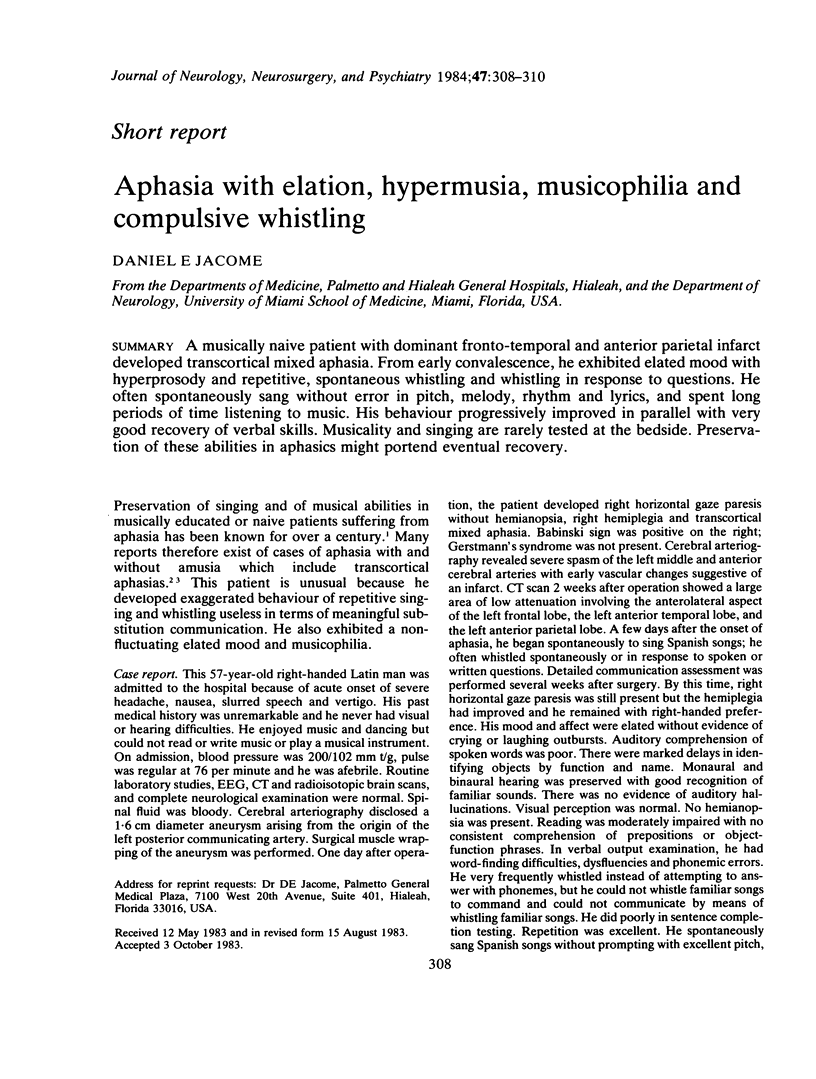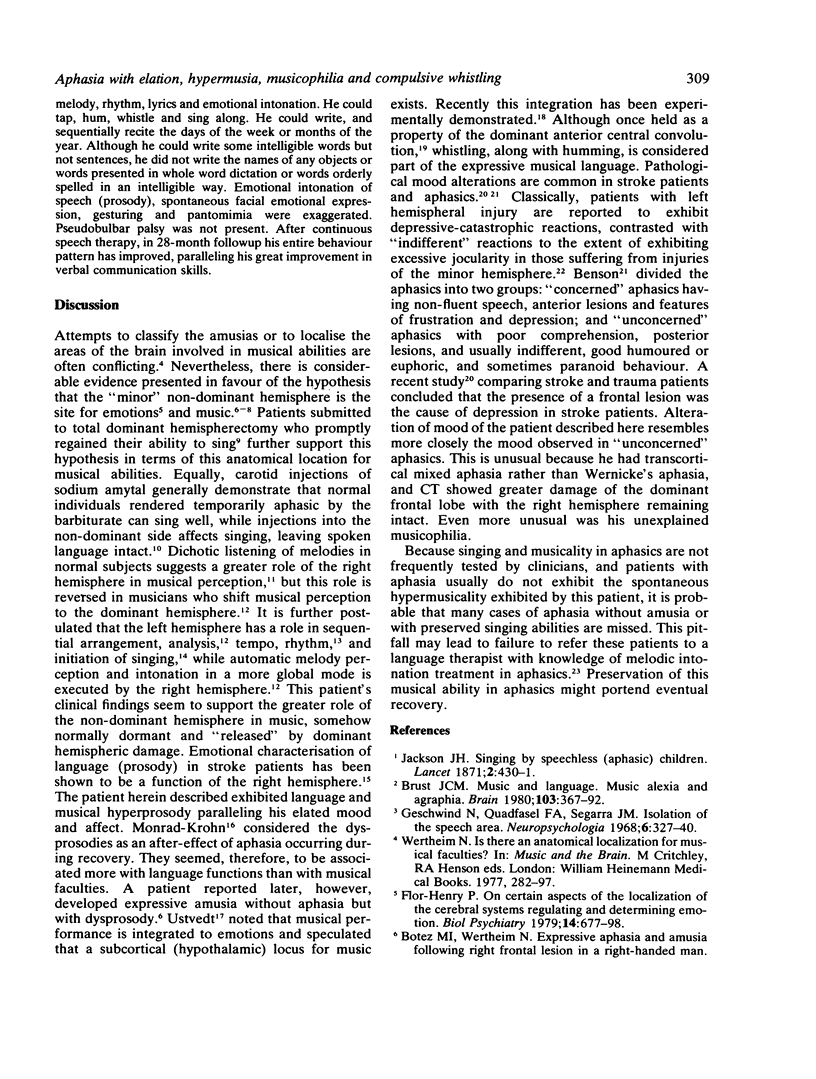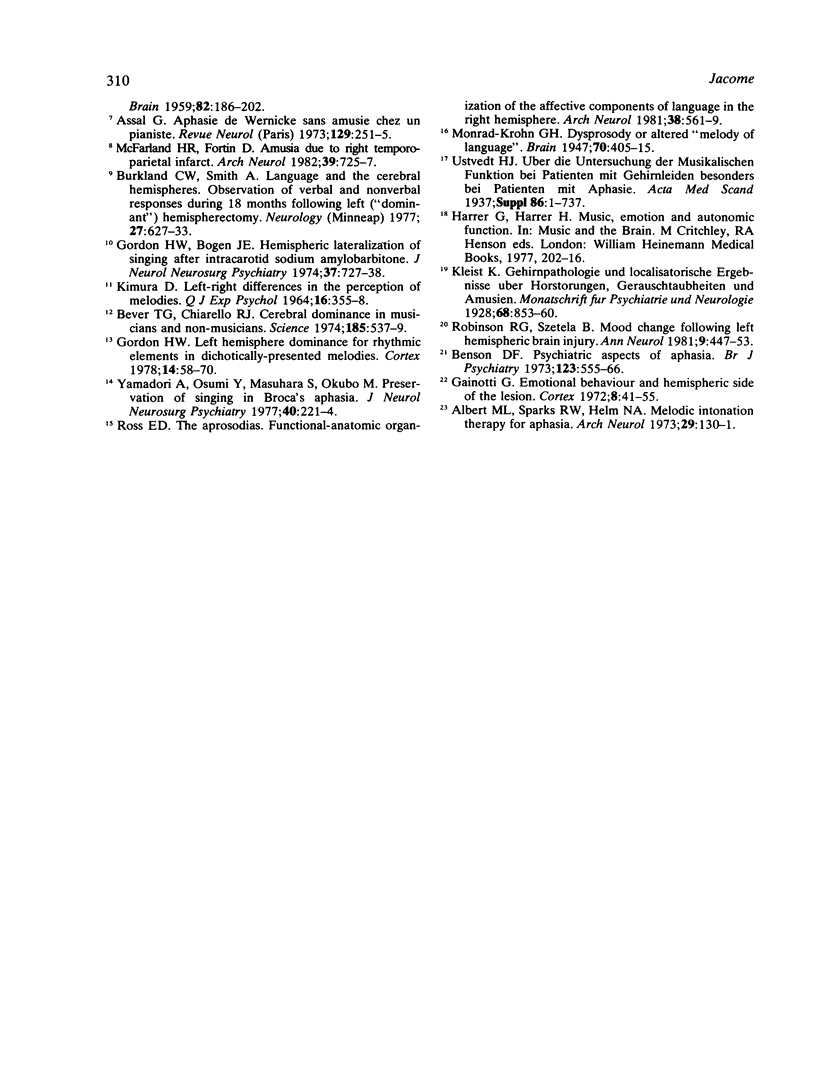Abstract
A musically naive patient with dominant fronto-temporal and anterior parietal infarct developed transcortical mixed aphasia. From early convalescence, he exhibited elated mood with hyperprosody and repetitive, spontaneous whistling and whistling in response to questions. He often spontaneously sang without error in pitch, melody, rhythm and lyrics, and spent long periods of time listening to music. His behaviour progressively improved in parallel with very good recovery of verbal skills. Musicality and singing are rarely tested at the bedside. Preservation of these abilities in aphasics might portend eventual recovery.
Full text
PDF


Selected References
These references are in PubMed. This may not be the complete list of references from this article.
- Albert M. L., Sparks R. W., Helm N. A. Melodic intonation therapy for aphasia. Arch Neurol. 1973 Aug;29(2):130–131. doi: 10.1001/archneur.1973.00490260074018. [DOI] [PubMed] [Google Scholar]
- Assal G. Aphasie de Wernicke sans amusie chez un pianiste. Rev Neurol (Paris) 1973 Nov;129(5):251–255. [PubMed] [Google Scholar]
- Benson D. F. Psychiatric aspects of aphasia. Br J Psychiatry. 1973 Nov;123(576):555–566. doi: 10.1192/bjp.123.5.555. [DOI] [PubMed] [Google Scholar]
- Bever T. G., Chiarello R. J. Cerebral dominance in musicians and nonmusicians. Science. 1974 Aug 9;185(4150):537–539. doi: 10.1126/science.185.4150.537. [DOI] [PubMed] [Google Scholar]
- Brust J. C. Music and language: musical alexia and agraphia. Brain. 1980 Jun;103(2):367–392. doi: 10.1093/brain/103.2.367. [DOI] [PubMed] [Google Scholar]
- Burklund C. W., Smith A. Language and the cerebral hemispheres. Observations of verbal and nonverbal responses during 18 months following left ("dominant") hemisphrerectomy. Neurology. 1977 Jul;27(7):627–633. doi: 10.1212/wnl.27.7.627. [DOI] [PubMed] [Google Scholar]
- Camp R., Jones R. R., Brain S., Woollard P., Greaves M. Production of intraepidermal microabscesses by topical application of leukotriene B4. J Invest Dermatol. 1984 Feb;82(2):202–204. doi: 10.1111/1523-1747.ep12259945. [DOI] [PubMed] [Google Scholar]
- Flor-Henry P. On certain aspects of the localization of the cerebral systems regulating and determining emotion. Biol Psychiatry. 1979 Aug;14(4):677–698. [PubMed] [Google Scholar]
- Gainotti G. Emotional behavior and hemispheric side of the lesion. Cortex. 1972 Mar;8(1):41–55. doi: 10.1016/s0010-9452(72)80026-1. [DOI] [PubMed] [Google Scholar]
- Gordon H. W., Bogen J. E. Hemispheric lateralization of singing after intracarotid sodium amylobarbitone. J Neurol Neurosurg Psychiatry. 1974 Jun;37(6):727–738. doi: 10.1136/jnnp.37.6.727. [DOI] [PMC free article] [PubMed] [Google Scholar]
- Gordon H. W. Left hemisphere dominance for rhythmic elements in dichotically-presented melodies. Cortex. 1978 Mar;14(1):58–70. doi: 10.1016/s0010-9452(78)80008-2. [DOI] [PubMed] [Google Scholar]
- McFarland H. R., Fortin D. Amusia due to right temporoparietal infarct. Arch Neurol. 1982 Nov;39(11):725–727. doi: 10.1001/archneur.1982.00510230051016. [DOI] [PubMed] [Google Scholar]
- Ross E. D. The aprosodias. Functional-anatomic organization of the affective components of language in the right hemisphere. Arch Neurol. 1981 Sep;38(9):561–569. doi: 10.1001/archneur.1981.00510090055006. [DOI] [PubMed] [Google Scholar]
- Yamadori A., Osumi Y., Masuhara S., Okubo M. Preservation of singing in Broca's aphasia. J Neurol Neurosurg Psychiatry. 1977 Mar;40(3):221–224. doi: 10.1136/jnnp.40.3.221. [DOI] [PMC free article] [PubMed] [Google Scholar]


